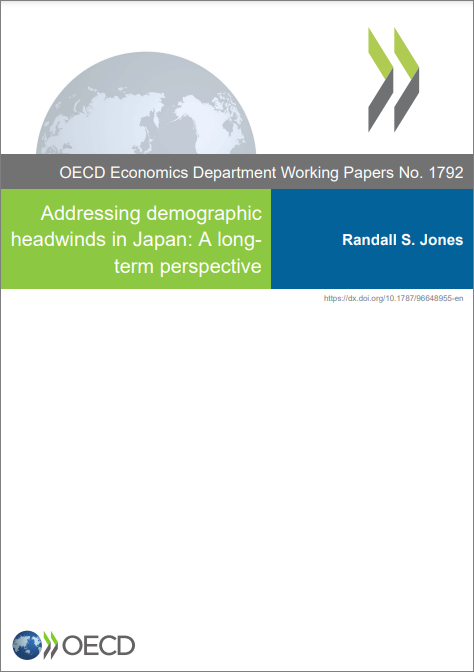
목차
Title page
Contents
Abstract/Résumé 4
Reversing the decline in the total fertility rate 10
Increasing labour market opportunities for women 29
Removing obstacles to the employment of older persons 37
Making greater use of foreign workers 44
References 54
Table 1. Japan's population has been ageing rapidly 8
Table 2. Public spending on family policies in Japan has risen considerably since 2000 20
Table 3. Female participation rates under alternative policy scenarios (for the 25-64 age group) 34
Table 4. Raising the pensionable age leads to a significant rise in the replacement rate 42
Table 5. Temporary migrants account for most of labour migrants to Japan 52
Figure 1. Japan's population and employment will decline significantly under current parameters 8
Figure 2. Japan's elderly dependency ratio is high and will continue rising 9
Figure 3. Reforms to boost fertility, employment rates and foreign worker inflows would mitigate the decline in employment 9
Figure 4. Japan's total fertility rate has remained below two since 1975 10
Figure 5. The relationship of fertility with per capita income and female employment has evolved 11
Figure 6. The share of single persons and the mean age of marriage have risen significantly 12
Figure 7. Childlessness is relatively high among Japanese women 13
Figure 8. The number of children for couples by years of marriage has edged down 13
Figure 9. The decline in the number of births is accelerating 14
Figure 10. Government spending on elderly far outpaces outlays for families 15
Figure 11. Population and labour force projections under different fertility scenarios 16
Figure 12. A number of factors result in a gap between the actual and ideal number of children 17
Figure 13. The low wages of non-regular workers increase the share who are single 19
Figure 14. Public expenditure on family support in Japan is relatively low 20
Figure 15. Childcare enrolment and capacity and female employment have risen 21
Figure 16. The take-up of parental leave by men is low and the duration is short 24
Figure 17. Enrolment in after-school tutoring institutions (juku) is common 26
Figure 18. The gender imbalance in paid and unpaid work is large 27
Figure 19. Japanese women are giving birth at an older age 28
Figure 20. Gender disparities in Japan's labour market remain large 30
Figure 21. Labour force projections if female employment rises to the rate for men by 2050 31
Figure 22. Non-regular employment is concentrated among women 31
Figure 23. The rate of non-regular employment is much higher among married women 32
Figure 24. Earnings of non-regular workers are low compared to regular workers 33
Figure 25. Tax and social insurance reform could boost female labour participation rates 35
Figure 26. Women's share of management positions is low 37
Figure 27. Employment rates for older persons have trended up in the past few decades 37
Figure 28. Long-run labour force projections with a rise in the employment rate of older persons 38
Figure 29. Japan's seniority-based wage system remains strong 39
Figure 30. Most companies still set a mandatory retirement age of 60 40
Figure 31. Many workers become non-regular employees at age 60 40
Figure 32. Japan ranks low on the OECD's Priorities for Adult Learning dashboard 43
Figure 33. Japan's foreign population is relatively small but increasing 45
Figure 34. Net emigration of foreigners to Japan has risen since 2012 46
Figure 35. The number of foreign workers in Japan is rising 46
Figure 36. Foreign workers tend to be employed in small firms and in the service sector 47
Figure 37. The impact of increased net immigration on employment in Japan 48
Figure 38. There is room to improve policies to attract and integrate foreign workers 49
Figure 39. Foreign workers in the Specified Skilled Worker Programme cover a range of sectors 51
Boxes
Box 1. Government policies aimed at increasing the fertility rate 14
Box 2. The government's new plan to increase the fertility rate 17
Box 3. Public support for children and families in France 22
Box 4. Parental leave policies in Sweden and Norway 23


